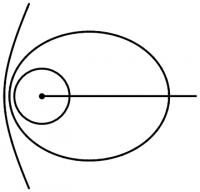
How do objects move in Newtonian gravity? We all know that objects in orbit move on ellipses, and that “slingshot” hyperbolic trajectories also exist. The various possibilities, also including circular orbits and radial trajectories, are shown in Figure 1. If the source is a point mass, only radial trajectories can hit it. But where do these trajectories come from?
A standard problem in Newtonian mechanics is to analyze falling objects near the surface of the Earth, with the acceleration due to gravity assumed to be constant ($g$). In this case, conservation of energy takes the form \begin{equation} E = \frac12 Mv^2 + Mgh \end{equation} where the first term is the kinetic energy of an object of mass $M$ traveling at speed $v$, and the second term is the potential energy of this object at height $h$ above the surface of the Earth. But where does this expression for the potential energy come from?
The gravitational field of a point mass $m$ is given by \begin{equation} \GG = -G \frac{m}{r^2}\,\rhat \end{equation} where $G$ is the gravitational constant. The gravitational potential $\Phi$ satisfies \begin{equation} \GG = -\grad\Phi \end{equation} from which it follows that \begin{equation} \Phi = - G \frac{m}{r} \end{equation} The potential energy of an object with mass $M$ in this gravitational field is just \begin{equation} V = M\Phi \end{equation} At the surface of the Earth ($r=R$), the acceleration due to gravity is \begin{equation} g = |\GG| = G\frac{m}{R^2} \end{equation} Finally, if we compare the potential energy at nearby radii, we get \begin{equation} V\Big|_R^{R+h} = -MG\frac{m}{R+h} + MG\frac{m}{R} = MG\frac{mh}{R(R+h)} \approx Mgh \end{equation}
Thus, in Newtonian mechanics, the conserved energy of an object of mass $M$ moving in the gravitational field of a point mass $m$ is \begin{equation} E = \frac12 Mv^2 - G\frac{Mm}{r} \label{Enewton1} \end{equation} In the equatorial plane, we have as usual \begin{equation} v^2 = \frac{ds^2}{dt^2} = \dot{r}^2 + r^2\dot\phi^2 \label{vnewton} \end{equation} and we also have the conserved angular momentum 1) \begin{equation} L = Mr^2\dot\phi \label{Lnewton} \end{equation} Inserting expressions ($\ref{vnewton}$) and ($\ref{Lnewton}$) into ($\ref{Enewton1}$), we obtain \begin{equation} \frac12 M\dot{r}^2 = E - \left(-G\frac{Mm}{r} + \frac{L^2}{2Mr^2}\right) \label{rdotn0} \end{equation} which can be rewritten in terms of the energy per unit mass ($e=E/M$) and angular momentum per unit mass ($\ell=L/M$) by dividing both sides by $M$.